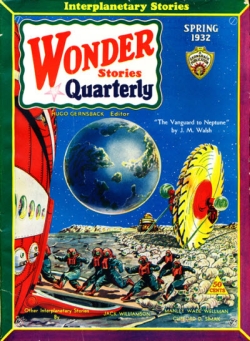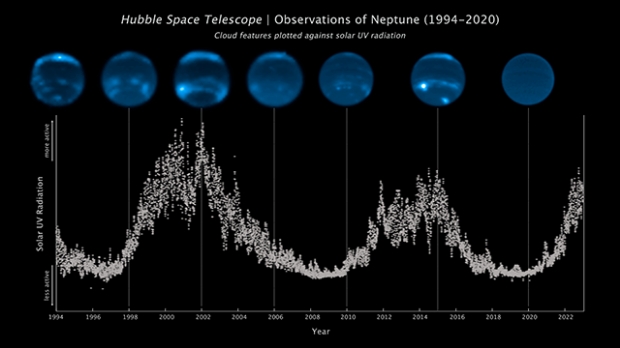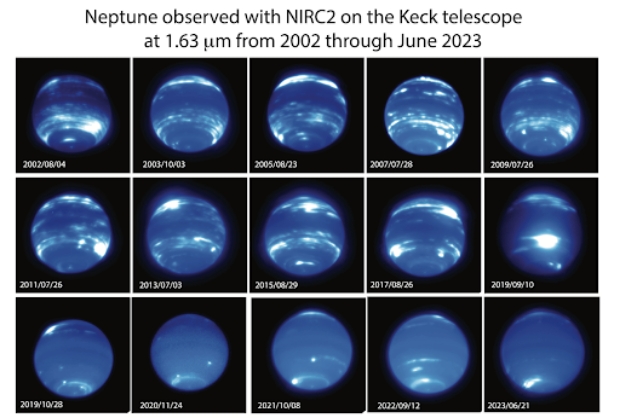As a book-dazzled kid growing up in St. Louis, I had the good fortune to be surrounded by books from previous generations, and specifically those belonging both to my father and my half-brother, who had died long before I was born. Among these was a multi-volume encyclopedia from the 1920s I’ve never been able to identify. All I have is the memory of looking through its musty volumes and realizing that Pluto was not listed in it, as the publication date was a few years earlier than Clyde Tombaugh’s epic search for the world.

I do remember thinking that without Pluto, the Solar System only had eight planets, and musing in my teenage boy way about how odd this incomplete view of the Solar System was. Little did I know how much more was in store! As to that eighth planet, Neptune was a puzzler not only to the encyclopedia but to science fiction writers of the Gernsback era. Thus James Morgan Walsh’s “The Vanguard to Neptune,” published in Wonder Stories Quarterly in the Spring, 1932 issue. In the cover by Frank R. Paul, that’s Neptune hanging in the sky, looking for all the world like a terrestrial planet, here seen from Triton. The explorers assume the blue areas are ice until they cross to the planet.
Image: Frank R. Paul’s cover illustration for J. M. Walsh’s “The Vanguard to Neptune.” Walsh (1897-1952) was an interesting figure in his own right for those of us who spent a career living off the printed word. Settling in the UK, the Australian novelist would pen an astounding 94 novels across a wide range of genres and under a variety of pseudonyms. It was possible to do that kind of thing in the pulp era.
Spurring these recollections are images of Neptune revealed in a new study on the planet’s cloud cover and its relation to the solar cycle. They’re so stunning that I wanted to reproduce them here, thinking about how our knowledge of the Solar System has advanced since my first acquaintance with the planet in that encyclopedia as no more than a speck of light amongst countless others. There’s also a bit of the Voyager 2 thrill as the craft approached Neptune back in 1989 deep in the summer night here. To see new worlds open before us. Astonishing.
I suppose one day we’ll get so completely accustomed to imaging exoplanets that such thrills will seem commonplace, or maybe not, given their sheer diversity. But the images below still work for me, the first set from Hubble.

Image: This sequence of Hubble Space Telescope images chronicles the waxing and waning of the amount of cloud cover on Neptune. This nearly-30-year-long set of observations shows that the number of clouds grows increasingly following a peak in the solar cycle – where the Sun’s level of activity rhythmically rises and falls over an 11-year period. The Sun’s level of ultraviolet radiation is plotted in the vertical axis. The 11-year cycle is plotted along the bottom from 1994 to 2022. The Hubble observations along the top, clearly show a correlation between cloud abundance and solar peak of activity. The chemical changes are caused by photochemistry, which happens high in Neptune’s upper atmosphere and takes time to form clouds. Credit: NASA, ESA, LASP, Erandi Chavez (UC Berkeley), Imke de Pater (UC Berkeley).
I don’t mean to neglect the import of the paper that features these observations, which comes from astronomers at UC-Berkeley, or their conclusions, which use the numerous changes in the patterning of Neptune’s clouds to point to the connection with the flip in the Sun’s magnetic field every eleven years. It’s intriguing to learn that when the Sun emits more intense ultraviolet light, and in particular the strong hydrogen Lyman-alpha emission, there is increasing cloud cover on Neptune fully two years later.
Imke de Pater (UC-Berkeley) is senior author on the study:
“These remarkable data give us the strongest evidence yet that Neptune’s cloud cover correlates with the Sun’s cycle. Our findings support the theory that the Sun’s UV rays, when strong enough, may be triggering a photochemical reaction that produces Neptune’s clouds.”
We see 2.5 cycles of cloud activity on Neptune recorded over a 29-year period in observations not only from Hubble but Keck Observatory and Lick Observatory, in which it also becomes clear that there is a relationship between the number of clouds and the planet’s observed brightness. Below is the Keck imagery.

Image: A dramatic change in Neptune’s appearance was observed in late 2019 and has persisted through June 2023. As shown by this compilation of images at 1.63 µm (microns) obtained with the NIRC2 and adaptive optics system on the Keck II Telescope, Neptune had numerous cloud features organized in latitudinal bands from before 2002 through late 2019. Afterwards, clouds appeared almost absent except near the south pole. The images are displayed using a Asinh function which, like a log-scale display, decreases the contrast between the features; if displayed on a linear scale, only the brightest features would be visible. Credit: Imke de Pater, Erandi Chavez, Erin Redwing (UC Berkeley)/W. M. Keck Observatory.
This is tricky analysis, because as the paper points out, clouds not related to photochemical reactions, as for example those produced by storms rising up from the deep atmosphere, would complicate correlations with the solar cycle. More recent imagery from the summer of this year has begun to show more clouds in the northern latitudes and at high altitude, which de Pater says reflects the observed increase in the solar ultraviolet flux in the past two years. It’s chastening to realize that even with 30 years of high resolution data covering almost three solar cycles, we have still covered only 20 percent of Neptune’s orbit. Oh for an ice-giant orbiter to depict up close the chaotic actions on a planet whose winds are the strongest known in the Solar System.
The paper is Chavez et al., “Evolution of Neptune at near-infrared wavelengths from 1994 through 2022,” Icarus Vol. 404 (1 November 2023), 115667 (abstract).



I bet you a quarter the book was Omnibus of Science Fiction (1952).
No, this was an actual encyclopedia. Was the Omnibus one of Conklin’s anthologies? I think I have it around here, as I have most of Conklin’s stuff. But the Walsh story never made it into one of them.
I wonder if the encyclopaedia series was the Arthur Mee’s Children’s Encyclopaedia? We had this at home, and as a young child I learnt a lot about a lot of subject, although even then I remember being aware that this was quite an old and somewhat outdated encyclopaedia and that there were a number of subjects (e.g., religion) where the views were quite one-sided. A quick look on Google Images will tell you whether this was the one you read.
Thanks for the idea, Mark, but the encyclopedia I’m remembering was not a children’s encyclopedia. On the other hand, it was no Britannica, but it did contain a lot of information. Unfortunately, it disappeared when my mother moved and I can’t recall the name. Frustrating.
It isn’t at first glance clear what photochemical reactions are happening in the H/He atmosphere. Is CH4 from the lower, liquid atmosphere being released in some way to the atmosphere and turned into smog, like that of Titan’s atmosphere?
In the mid-1960s, Neptune was still little more than a bright light in the sky. My copy of “The New Solar System” (1981) has images of Neptune, spectrally filtered to show CH4, showing bright areas of what is interpreted as CH4 ice in the atmosphere, with a dimmer equatorial band interpreted as CH4 in the lower atmosphere.
If this interpretation remains correct, then the photochemical reaction of the CH4 ice in the atmosphere is to form longer-chain hydrocarbons similar to those on Saturn’s moon, Titan. Titan’s atmosphere and climate
15 years earlier, when even less was known about Neptune, Eagle comic’s Dan Dare artist Keith Watson depicted Triton as an ice world, with Neptune more like a gas giant than an ice giant, as shown in this image:
The Moonsleepers. [If only we could have fast spacecraft driven by radiated impulse waves, and a solar system full of interesting native populations.]
“a solar system full of interesting native populations”
Considering the situations with the various populations just on this Earth, it may be prudent to rein in one’s imagination.
Yes, some were not so pleasant. The Mekon and the Treens on Venus – always up to some mischief. Then there were the extrasolar aliens – Xel, the Pittars, etc. But many were good – the Atlanteans and Therons on Venus, and the Mercurians.
Just as Star Trek has a galaxy full of humanoid races, Dan Dare had a solar system of races, as well as interstellar ones once star drives became possible. These races were not as obviously political comments during the Cold War, like the Klingons and Romulans. And all around the end of the 20th century.
The Wonder Stories Quarterly issue is available at the Internet Archive:
https://archive.org/details/Wonder_Stories_Quarterly_v03n03_1932-Spring/page/n1/mode/2up
The Frank R. Paul artwork (there are a few B&W illustrations in the issue) are great.
Isn’t it wonderful to have the old pulps preserved this way? I read a good deal of the Walsh story this way, even though I have that issue in my collection. The problem is that these old magazines are so fragile that I hesitate to open them up!
Thanks for the link! It is always interesting to look at these old stories. They represent their era’s scientific juvenility, but this is at least as much in the sense of vigor and daring as in terms of error and shortcut. Walsh had some key notions…
a) Neptune’s surface gravity (like that of Uranus and Saturn) is quite similar to that of Earth (though his given figure would better match the truth for lighter, puffier Uranus)
b) It is a myth that Neptune is “a dead world, lifeless and heatless, too far away from our father, the sun, to receive more than a minute fraction of his warmth.”
c) Neptune’s low density depends, in part, on a sea of a strange, light, liquid metal deep below the surface.
Though the story is a bit optimistic to promote a Neptune with continents visible from space, there were some grains of truth to all of these. Neptune is indeed a paradoxical world, so much hotter than Uranus that any hope of that planet’s potential deep liquid ocean resting atop supercritical fluid water seems lost. Its magnetic field, though not quite so prone to induced aberration as in the story, seems to vary from a simple dipole. It has been proposed to emanate from a sea of fluid metallic hydrogen at 90% of the planet’s radius (open access: https://iopscience.iop.org/article/10.1088/1742-6596/950/4/042046 ). Beneath that, a vast sea of supercritical “ice” may lie over a rocky core perhaps not so different than Earth, except in temperature.
As on Saturn, Uranus, Jupiter, and Venus, perhaps any hot world with cold cloud tops, there is some level between hot and cold where water can accumulate, suspended in the atmosphere, and Earthlike life might conceivably exist. But I suspect Neptune’s glory days might come far in the future. As it slowly continues to cool over billions of years, assisted perhaps if it is cast entirely out of the Sun’s baleful glow by some rearrangement of orbits during the red giant phase, it should develop a truly liquid ocean with a temperature low enough not to shake apart every complex molecule according to delta-G = delta-H minus T delta-S. Life forms should not do without energy, because any complex molecules that sink are bound to be broken up into small components per that relation, that can be combined to produce free energy when they rise by convection to lower temperatures. The abundance of methane might top the new liquid ocean with a crustal layer of oils and solid organic compounds awaiting whatever life desires to clamber onto land. And the dense hydrogen-helium atmosphere remaining above that should be fine for all manner of dragons.